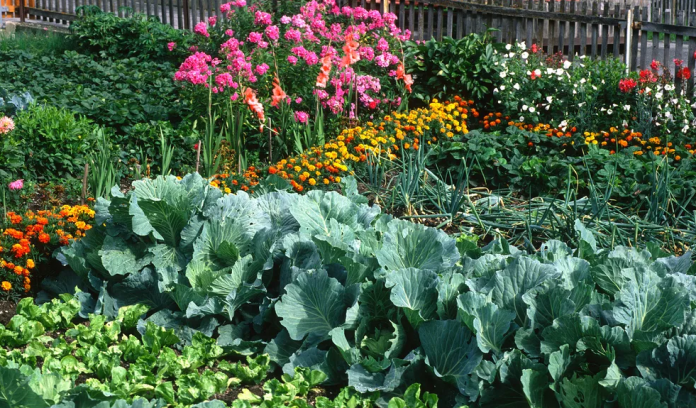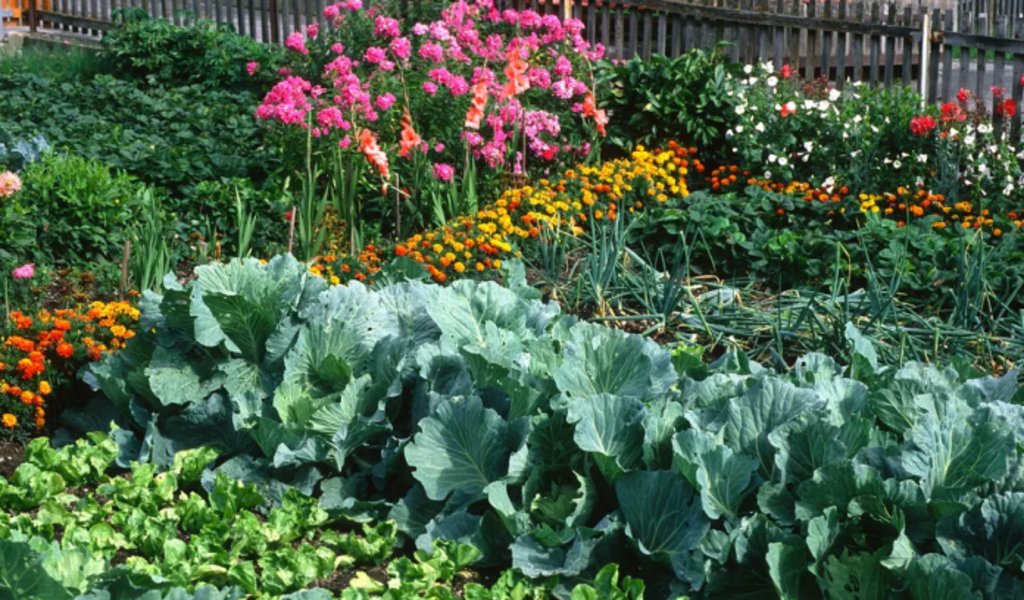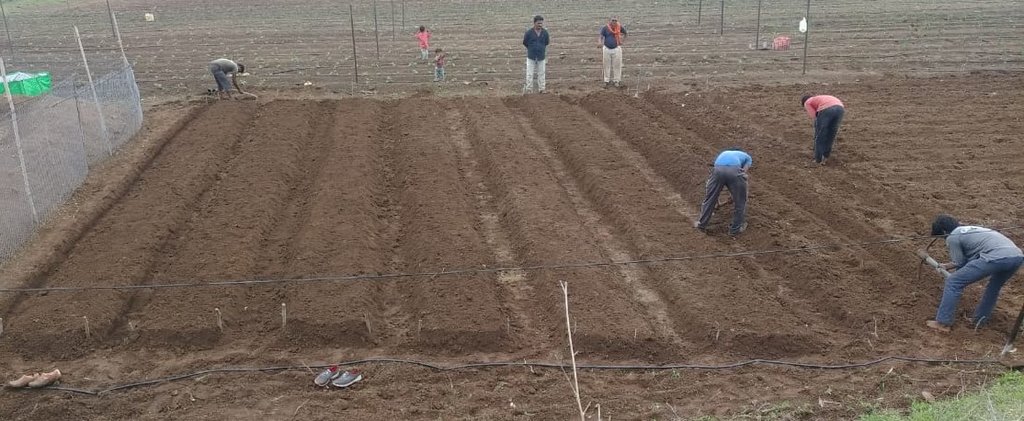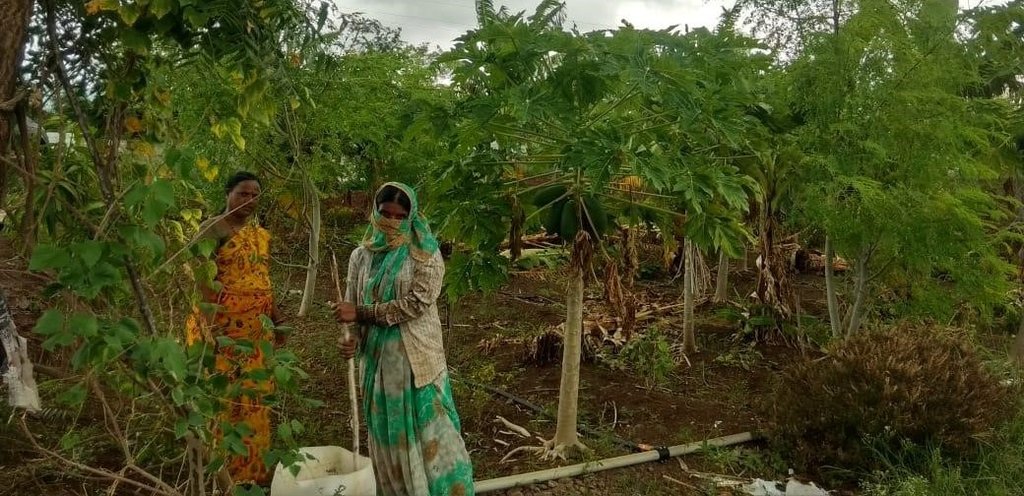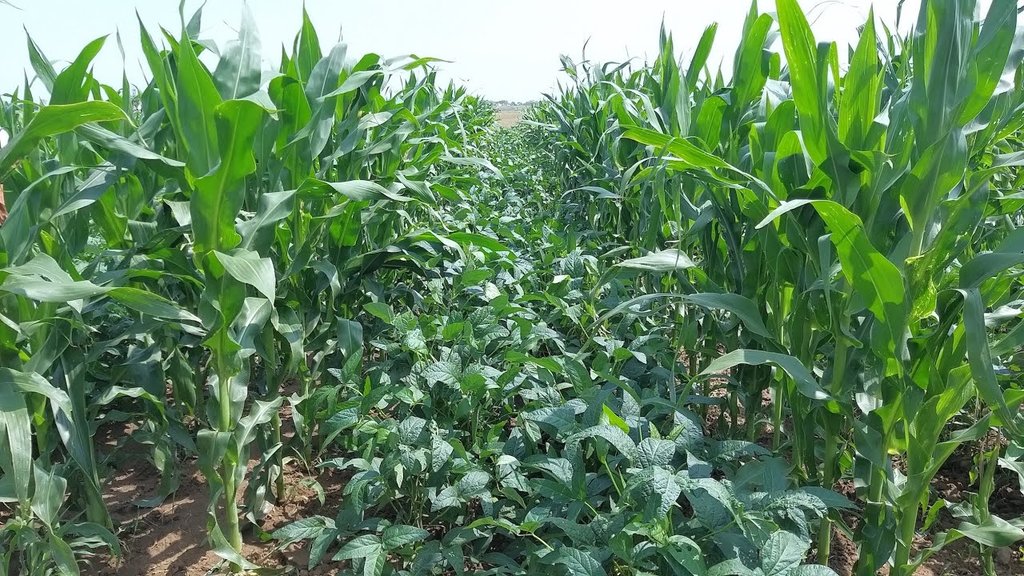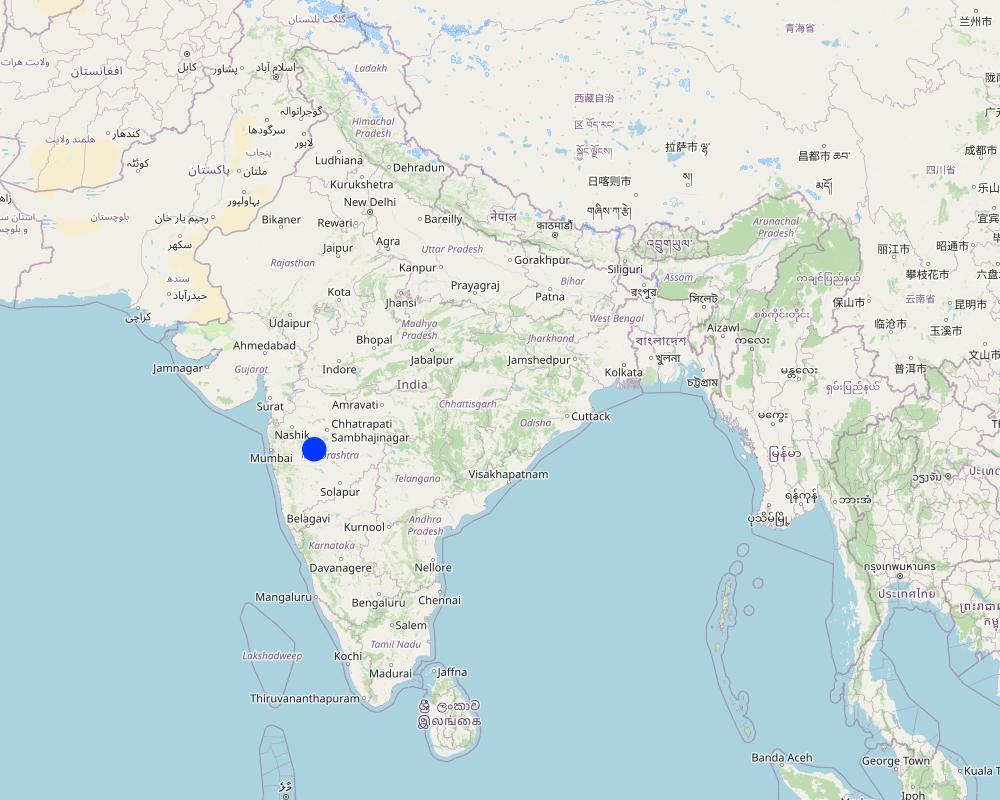Multilayer Farming Systems For Ensuring Food Diversity And Increasing Resilience [อินเดีย]
- ผู้สร้างสรรค์:
- การอัพเดท:
- ผู้รวบรวม: Santosh Gupta
- ผู้เรียบเรียง: Noel Templer, Stephanie Katsir
- ผู้ตรวจสอบ: Udo Höggel, Rima Mekdaschi Studer
Mishrit kheti
technologies_6724 - อินเดีย
- บทสรุปทั้งหมดในรูปแบบของ PDF
- บทสรุปทั้งหมดในรูปแบบของ PDF เพื่อพิมพ์
- บทสรุปทั้งหมดในรูปหน้าเว็บ
- บทสรุปทั้งหมด (ไม่มีการจัดเรียง)
- Multilayer Farming Systems For Ensuring Food Diversity And Increasing Resilience: 5 ตุลาคม 2023 (inactive)
- Multilayer Farming Systems For Ensuring Food Diversity And Increasing Resilience: 20 พฤศจิกายน 2023 (inactive)
- Multilayer Farming Systems For Ensuring Food Diversity And Increasing Resilience: 17 เมษายน 2024 (public)
ดูส่วนย่อย
ขยายทั้งหมด ย่อทั้งหมด1. ข้อมูลทั่วไป
1.2 รายละเอียดที่ติดต่อได้ของผู้รวบรวมและองค์กรที่เกี่ยวข้องในการประเมินและการจัดเตรียมทำเอกสารของเทคโนโลยี
ชื่อของโครงการซึ่งอำนวยความสะดวกในการทำเอกสารหรือการประเมินเทคโนโลยี (ถ้าเกี่ยวข้อง)
Soil protection and rehabilitation for food security (ProSo(i)l)ชื่อขององค์กรซึ่งอำนวยความสะดวกในการทำเอกสารหรือการประเมินเทคโนโลยี (ถ้าเกี่ยวข้อง)
Deutsche Gesellschaft für Internationale Zusammenarbeit (GIZ)ชื่อขององค์กรซึ่งอำนวยความสะดวกในการทำเอกสารหรือการประเมินเทคโนโลยี (ถ้าเกี่ยวข้อง)
Alliance Bioversity and International Center for Tropical Agriculture (Alliance Bioversity-CIAT) - เคนยาชื่อขององค์กรซึ่งอำนวยความสะดวกในการทำเอกสารหรือการประเมินเทคโนโลยี (ถ้าเกี่ยวข้อง)
Ecociate Consultants (Ecociate Consultants) - อินเดีย1.3 เงื่อนไขการใช้ข้อมูลที่ได้บันทึกผ่านทาง WOCAT
ผู้รวบรวมและวิทยากรหลักยอมรับเงื่อนไขเกี่ยวกับการใช้ข้อมูลที่ถูกบันทึกผ่านทาง WOCAT:
ใช่
1.4 การเปิดเผยเรื่องความยั่งยืนของเทคโนโลยีที่ได้อธิบายไว้
เทคโนโลยีที่ได้อธิบายไว้นี้เป็นปัญหาของความเสื่อมโทรมโทรมของที่ดินหรือไม่ จึงไม่ได้รับการยอมรับว่าเป็นเทคโนโลยีเพื่อการจัดการที่ดินอย่างยั่งยืน:
ไม่ใช่
แสดงความคิดเห็น:
Multilayer farming is a farming practice that involves cultivating a mix of vegetables and fruits on a small piece of land. Additionally, by growing a variety of crops together, multilayer farming can increase yields and provide a more diverse range of foods for households.
2. การอธิบายลักษณะของเทคโนโลยี SLM
2.1 การอธิบายแบบสั้น ๆ ของเทคโนโลยี
คำจำกัดความของเทคโนโลยี:
Multilayer farming, also known as multi-tier farming, is a technique of intercropping crops of different heights, root and shoot patterns, and maturation times in small plots of land. This technique is cost-effective, easily adaptive, and participatory, providing a large number of food groups to farmers to improve their nutritional levels, providing insurance against crop failure, reducing pest and disease incidence, and improving soil properties and soil fertility conditions. Multilayer farming minimizes crop-weed competition, and soil erosion, and optimizes resource utilization resulting in higher returns and better nutritional value. It promotes sustainable agriculture, maintains a balanced diet, increases income per unit area, and reduces the risk of crop failure.
2.2 การอธิบายแบบละเอียดของเทคโนโลยี
คำอธิบาย:
Multilayer farming is an agricultural model that aims at achieving maximum production per unit area by utilizing water, manure, and land resources to their full potential. This method is based on the synergies between the different crops and plants planted on a given piece of land. This method is cost-effective and yields more benefits than other farming systems. By cultivating four to five crops with the same amount of fertilizer and water required for a single crop, farmers can increase their income, and multiple crops can be harvested yearly using the same piece of land.
Multilayer farming is based on scientific, ecological, and economic principles, promoting crop diversification, maximizing productivity, utilizing resources more efficiently, and promoting intensive input use. Moreover, it ensures the sustainability of farm resources and the environment in the long term.
The multilayer farming system mainly consists of an overstory of trees or shrubs with an understory of economic or forage crops. By incorporating these principles, farmers can achieve greater yields and financial success while promoting environmental sustainability.
As a part of the program's approach, WOTR (Watershed Organisation Trust, the project implementing partner trained women change-makers) to spread awareness among villagers about the importance of nutrition and a healthy diet. Since 2018, the active promotion of multilayer farming to address food and nutrition insecurity in Maharashtra is undertaken. As a result, 1124 plots across 150 villages in Maharashtra have adopted this unique farming method to enhance food and nutrition security.
The multilayer farming system involves several steps to ensure maximum productivity from the available resources.
1.The first step is land preparation, which involves applying 300 kg of cow dung or vermicompost along with one kg of Trichoderma powder per 36 x 36 feet plot. Trichoderma is a bio-fungicide that helps to prevent fungal infections in plants and roots.
2.Next, eight beds of 3 x 36 feet are prepared with 1.5 to 2 feet of space left in between. These beds need to be arranged in the North-South direction to ensure that plants receive adequate sunlight.
3.After preparing the bed, 1-foot deep channels are dug to drain excess water so ensuring that the crops are not waterlogged.
4.Finally, in the middle of each bed, vegetable and fruit crops are planted according to a crop planning chart. By planting a variety of crops in the same plot, the multilayer farming system ensures the effective utilization of resources and provides an even distribution of income and employment throughout the year by producing several off-season crops.
The multilayer farming system has numerous benefits that make it an effective and sustainable farming method. It makes effective use of soil, water, and other resources, reducing waste and increasing productivity. Additionally the system reduces climate-specific damage and enhances soil health, helping to maintain an ecological balance in the environment. The soil covered minimizes water loss due to soil evaporation, generating a higher income per unit area with an even distribution of income and employment throughout the year. The multilayer farming system generates jobs and allows for better utilization of labor while reducing the impacts of climate-specific hazards such as high-intensity rainfall, soil erosion, and landslides. Multilayer farming also utilizes soil moisture at different depths and solar energy at different heights, improving soil characteristics and adding organic matter to the soil. It reduces pests and disease infestation and provides micro-climate conditions which ensure better productivity of crops underneath. Overall, multilayer farming is a sustainable and efficient farming method that not only maximizes productivity but also enhances soil and environmental health while promoting economic and social well-being.
2.3 รูปภาพของเทคโนโลยี
คำอธิบายภาพ:
The images provide a visual representation of the essential steps followed by farmers to establish a successful multilayer farming system. These steps include land preparation, bed preparation, and planting a variety of crops in the same plot. The dates mentioned here are the dates of collection of these photos from the project implementing team as the photos were taken by different team members at different times.
2.5 ประเทศภูมิภาค หรือสถานที่ตั้งที่เทคโนโลยีได้นำไปใช้และได้รับการครอบคลุมโดยการประเมินนี้
ประเทศ:
อินเดีย
ภูมิภาค/รัฐ/จังหวัด:
Maharashtra
ข้อมูลจำเพาะเพิ่มเติมของสถานที่ตั้ง :
Ahmednagar
ระบุการกระจายตัวของเทคโนโลยี:
- ใช้ ณ จุดที่เฉพาะเจาะจงหรือเน้นไปยังบริเวณพื้นที่ขนาดเล็ก
Is/are the technology site(s) located in a permanently protected area?
ไม่ใช่
แสดงความคิดเห็น:
In Maharastra State, there are different districts where multilayer farming plots are established such as Ahmednagar, Satara, and Dhule
Map
×2.6 วันที่การดำเนินการ
ระบุปีที่ใช้:
2018
2.7 คำแนะนำของเทคโนโลยี
ให้ระบุว่าเทคโนโลยีถูกแนะนำเข้ามาอย่างไร:
- ในช่วงการทดลองหรือการทำวิจัย
- ทางโครงการหรือจากภายนอก
ความคิดเห็น (ประเภทของโครงการ เป็นต้น) :
The intervention is a result of experiments and research by WOTR and other agencies at different project locations
3. การจัดประเภทของเทคโนโลยี SLM
3.1 วัตถุประสงค์หลักของเทคโนโลยี
- ปรับปรุงการผลิตให้ดีขึ้น
- ลด ป้องกัน ฟื้นฟู การเสื่อมโทรมของที่ดิน
- ปรับตัวเข้ากับการเปลี่ยนแปลงภูมิอากาศของโลก สภาพภูมิอากาศที่รุนแรงและผลกระทบ
- สร้างผลกระทบทางด้านเศรษฐกิจที่เป็นประโยชน์
- สร้างผลกระทบทางด้านสังคมที่เป็นประโยชน์
- Ensure nutritional security
3.2 ประเภทของการใช้ที่ดินในปัจจุบันที่ได้นำเทคโนโลยีไปใช้
Land use mixed within the same land unit:
ไม่ใช่

พื้นที่ปลูกพืช
- การปลูกพืชล้มลุกอายุปีเดียว
Annual cropping - Specify crops:
- cereals - sorghum
- cereals - wheat (winter)
- Sugarcane, Horticulture crops like Pomegranate, Guava, Mango etc, Onion, pulses
จำนวนของฤดูเพาะปลูกต่อปี:
- 2
ระบุ:
In places where irrigation source is availbe the growing seasons vary between 2 to 3
Is intercropping practiced?
ใช่
Is crop rotation practiced?
ใช่
ถ้าใช่ ระบุ:
In places where irrigation is available, farmers grow Kharif crops (summer crops) followed by Rabi crops (winter crops).
แสดงความคิดเห็น:
The majority of farmers in various regions tend to practice mono-cropping due to rainfall variability and less rainfall in the region. However, in places where an irrigation source is available, farmers tend to grow second crops in the Rabi season or go for horticulture crops such as fruits and vegetables.
3.3 Has land use changed due to the implementation of the Technology?
Has land use changed due to the implementation of the Technology?
- Yes (Please fill out the questions below with regard to the land use before implementation of the Technology)
Land use mixed within the same land unit:
ใช่
Specify mixed land use (crops/ grazing/ trees):
- วนเกษตร (Agroforestry)

พื้นที่ปลูกพืช
- การปลูกพืชล้มลุกอายุปีเดียว
- การปลูกไม้ยืนต้น ไม้พุ่ม
- Horticulture Crops
Annual cropping - Specify crops:
- flower crops
- vegetables - other
- drumstick, marigold, radish, dolichos beans, coriander, spinach, fenugreek, dill, okra, brinjal, tomato, red pumpkin, maize, cowpea, castor, ridge gourd
Tree and shrub cropping - Specify crops:
- mango, mangosteen, guava
- papaya
- Sapota
Is intercropping practiced?
ใช่
If yes, specify which crops are intercropped:
In multi-cropping systems, fruits and vegetables are planted in a systematically planned manner using crop planning charts. This approach ensures that the growth of plants complements each other, providing adequate nutrition for the family throughout the year.
Is crop rotation practiced?
ใช่
ถ้าใช่ ระบุ:
The combination of vegetables is selected based on the suitability to climate conditions as tomatoes are grown during the winter season, beans during the summer seasons etc.
แสดงความคิดเห็น:
The land was mostly converted from mono-cropping systems to a multi-cropping system
3.4 การใช้น้ำ
การใช้น้ำของที่ดินที่มีการใช้เทคโนโลยีอยู่:
- น้ำฝนร่วมกับการชลประทาน
แสดงความคิดเห็น:
Multi-cropping systems involve covering the soil with crops throughout the year, which helps to reduce evaporation losses. In addition, irrigation is provided using drip or sprinkler systems to minimize water losses. This approach not only conserves water but also helps to maintain soil moisture levels, leading to higher yields and improved plant health. By adopting these practices, farmers can improve the sustainability and resilience of their agricultural systems.
3.5 กลุ่ม SLM ที่ตรงกับเทคโนโลยีนี้
- การปรับปรุงดิน / พืชคลุมดิน
- การจัดการด้านชลประทาน (รวมถึงการลำเลียงส่งน้ำ การระบายน้ำ)
- สวนครัว
3.6 มาตรการ SLM ที่ประกอบกันเป็นเทคโนโลยี

มาตรการจัดการพืช
- A1: พืช/สิ่งปกคลุมดิน
- A2: อินทรียวัตถุในดิน/ความอุดมสมบูรณ์ในดิน
- A5: การจัดการเมล็ดพันธุ์ การปรับปรุงพันธุ์

มาตรการอนุรักษ์ด้วยวิธีพืช
- V1: ต้นไม้และพุ่มไม้คลุมดิน

มาตรการอนุรักษ์ด้วยการจัดการ
- M1: การเปลี่ยนรูปแบบของการใช้ประโยชน์ที่ดิน
- M4: การเปลี่ยนแปลงช่วงเวลาให้เหมาะแก่การทำกิจกรรม
แสดงความคิดเห็น:
1. Effective utilization of natural resources
2. Reduces climate-specific damage & enhances soil health and reduces water loss due to evaporation from the soil
3. The income per unit area increases substantially with this system and multilayer farming ensures the yield of some crops throughout the year
4. Utilizes the soil moisture well at different depths of soil and effectively utilizes solar energy at different heights
5. Improve the soil characteristics and adds organic matter to the soil
6. Provides a partial guarantee against the market glut of a single commodity and the efficient cultivation of a range of products is possible
3.7 รูปแบบหลักของการเสื่อมโทรมของที่ดินที่ได้รับการแก้ไขโดยเทคโนโลยี

การเสื่อมโทรมของดินทางด้านกายภาพ
- Ps (Subsidence of organic soils): การยุบตัวของดินอินทรีย์ การทรุดตัวของดิน

การเสื่อมโทรมของดินทางด้านชีวภาพ
- Bc (Reduction of vegetation cover): การลดลงของจำนวนพืชที่ปกคลุมดิน
- Bq (Quantity/biomass decline): การลดลงของปริมาณหรือมวลชีวภาพ
- Bs (Quality and species composition): องค์ประกอบหรือความหลากหลายทางคุณภาพและชนิดพันธุ์ลดลง
- Bp (Increase of pests/diseases): การเพิ่มขึ้นของศัตรูพืชและโรคพืช
แสดงความคิดเห็น:
Multilayer farming covers the soil throughout the year with crops, fruits, and vegetables. The micro-climate enables diversified crops to grow together and provide nutrition to the family through out the year. The year around soil cover reduces soil erosion by wind and flood.
3.8 การป้องกัน การลดลง หรือการฟื้นฟูความเสื่อมโทรมของที่ดิน
ระบุเป้าหมายของเทคโนโลยีกับความเสื่อมโทรมของที่ดิน:
- ป้องกันความเสื่อมโทรมของที่ดิน
- ลดความเสื่อมโทรมของดิน
แสดงความคิดเห็น:
Multilayer farming improves soil fertility by improving the microbial activities in the soil as the ecosystem of different root zones, plants and organic matter coupled with organic inputs creates a healthy plant environment
4. ข้อมูลจำเพาะด้านเทคนิค กิจกรรมการนำไปปฏิบัติใช้ ปัจจัยนำเข้า และค่าใช้จ่าย
4.2 ข้อมูลทั่วไปเกี่ยวกับการคำนวณปัจจัยนำเข้าและค่าใช้จ่าย
ให้ระบุว่าค่าใช้จ่ายและปัจจัยนำเข้าได้รับการคำนวณอย่างไร:
- ต่อพื้นที่ที่ใช้เทคโนโลยี
ระบุขนาดและหน่วยพื้นที่:
1
If using a local area unit, indicate conversion factor to one hectare (e.g. 1 ha = 2.47 acres): 1 ha =:
ha
อื่นๆ หรือสกุลเงินประจำชาติ (ระบุ):
INR
If relevant, indicate exchange rate from USD to local currency (e.g. 1 USD = 79.9 Brazilian Real): 1 USD =:
80.0
ระบุค่าเฉลี่ยของค่าจ้างในการจ้างแรงงานต่อวัน:
200
4.3 กิจกรรมเพื่อการจัดตั้ง
| กิจกรรม | Timing (season) | |
|---|---|---|
| 1. | Land Preperation | June |
| 2. | Preperation of beds for seed sowing | June |
| 3. | Sowing of seeds for fruits | Early June |
| 4. | Fencing of the field | Before the sowing |
แสดงความคิดเห็น:
Farmers can use local resources such as Bamboo or other crop residues for fencing purposes as well. Land needs to be prepared before the onset of monsoon (during the summer season). Once a multilayer plot is established there is no need to prepare the land as well.
4.4 ค่าใช้จ่ายของปัจจัยนำเข้าที่จำเป็นสำหรับการจัดตั้ง
| ปัจจัยนำเข้า | หน่วย | ปริมาณ | ค่าใช้จ่ายต่อหน่วย | ค่าใช้จ่ายทั้งหมดต่อปัจจัยนำเข้า | %ของค่าใช้จ่ายที่ก่อให้เกิดขึ้นโดยผู้ใช้ที่ดิน | |
|---|---|---|---|---|---|---|
| แรงงาน | Land preparation | person days | 2.0 | 200.0 | 400.0 | 100.0 |
| แรงงาน | Preperation of beds for sowing | Person days | 3.0 | 200.0 | 600.0 | 100.0 |
| อุปกรณ์ | Fencing material | Lumpsum | 1.0 | 5000.0 | 5000.0 | 100.0 |
| วัสดุด้านพืช | Seeds for fruit trees (seeds and planting material) | Plant | 100.0 | 50.0 | 5000.0 | 100.0 |
| ปุ๋ยและสารฆ่า/ยับยั้งการเจริญเติบโตของสิ่งมีชีวิต (ไบโอไซด์) | Fram yard manure | Tons | 10.0 | 600.0 | 6000.0 | 100.0 |
| อื่น ๆ | Miscellaneous | 1.0 | 2000.0 | 2000.0 | 100.0 | |
| ค่าใช้จ่ายทั้งหมดของการจัดตั้งเทคโนโลยี | 19000.0 | |||||
| Total costs for establishment of the Technology in USD | 237.5 | |||||
แสดงความคิดเห็น:
Costs towards labour, farm yard manure and sometimes seeds are internally arranged by the land users thus there may not be any cost to pay.
4.5 การบำรุงรักษาสภาพหรือกิจกรรมที่เกิดขึ้นเป็นประจำ
| กิจกรรม | ช่วงระยะเวลา/ความถี่ | |
|---|---|---|
| 1. | Sowing of seeds | June-July/October-November/April/March/April |
| 2. | Application of organic manures | Across the year at critical growth stages |
| 3. | Irrigation | Across the year at critical growth stages |
| 4. | Bio-inputs | Based on the plant needs |
| 5. | Harvesting of leafy vegetables, fruits, fodder and other produces | Multiple plucking during the year |
| 6. | Sales of farm produces | Multiple times during the year |
แสดงความคิดเห็น:
Maintenance activities vary farmers to farmers depending upon the kind of fruits and vegetables planted, availability of resources and land area under cultivation
4.6 ค่าใช้จ่ายของปัจจัยนำเข้าและกิจกรรมที่เกิดขึ้นเป็นประจำที่ต้องการการบำรุงรักษา (ต่อปี)
| ปัจจัยนำเข้า | หน่วย | ปริมาณ | ค่าใช้จ่ายต่อหน่วย | ค่าใช้จ่ายทั้งหมดต่อปัจจัยนำเข้า | %ของค่าใช้จ่ายที่ก่อให้เกิดขึ้นโดยผู้ใช้ที่ดิน | |
|---|---|---|---|---|---|---|
| แรงงาน | Sowing of seeds | Person days | 8.0 | 200.0 | 1600.0 | 100.0 |
| แรงงาน | Application of FYM and other inputs | Person days | 5.0 | 200.0 | 1000.0 | 100.0 |
| แรงงาน | Maintenance and monitoring of the field | Person days | 50.0 | 100.0 | 5000.0 | 100.0 |
| แรงงาน | Harvesting | Person days | 20.0 | 200.0 | 4000.0 | 100.0 |
| วัสดุด้านพืช | Seeds and planting material | Kg | 0.25 | 1000.0 | 250.0 | 100.0 |
| ปุ๋ยและสารฆ่า/ยับยั้งการเจริญเติบโตของสิ่งมีชีวิต (ไบโอไซด์) | Farm yard manure and other inputs | Tons | 5.0 | 750.0 | 3750.0 | 100.0 |
| อื่น ๆ | Other cost | Lumpsum | 1.0 | 1000.0 | 1000.0 | 100.0 |
| ค่าใช้จ่ายทั้งหมดของการบำรุงรักษาสภาพเทคโนโลยี | 16600.0 | |||||
| Total costs for maintenance of the Technology in USD | 207.5 | |||||
แสดงความคิดเห็น:
These farms are mostly managed by the farmers themselves without hiring any additional labour. Thus, labour cost is not something farmers need to pay for.
4.7 ปัจจัยสำคัญที่สุดที่มีผลกระทบต่อค่าใช้จ่าย
ปัจจัยสำคัญที่สุดที่มีผลกระทบต่อค่าใช้จ่ายต่างๆ:
1. Availability of family labour to manage the field operations
2. Availability of dairy animals at the household level to meet the FYM needs
5. สิ่งแวดล้อมทางธรรมชาติและของมนุษย์
5.1 ภูมิอากาศ
ฝนประจำปี
- < 250 ม.ม.
- 251-500 ม.ม.
- 501-750 ม.ม.
- 751-1,000 ม.ม.
- 1,001-1,500 ม.ม.
- 1,501-2,000 ม.ม.
- 2,001-3,000 ม.ม.
- 3,001-4,000 ม.ม.
- > 4,000 ม.ม.
ระบุปริมาณน้ำฝนเฉลี่ยรายปี (ถ้ารู้) :หน่วย ม.ม.
561.00
ข้อมูลจำเพาะ/ความคิดเห็นเรื่องปริมาณน้ำฝน:
Deccan Plateau, Hot Semi-Arid Eco-Region as per the ICAR classification of Ecological Zone
ระบุชื่อของสถานีตรวดวัดอากาศที่ใช้อ้างอิงคือ:
https://krishi.icar.gov.in/jspui/bitstream/123456789/30264/1/MH14.pdf
เขตภูมิอากาศเกษตร
- กึ่งแห้งแล้ง
Length of growing period: less than 90 days
Rainy days: 44
5.2 สภาพภูมิประเทศ
ค่าเฉลี่ยความลาดชัน:
- ราบเรียบ (0-2%)
- ลาดที่ไม่ชัน (3-5%)
- ปานกลาง (6-10%)
- เป็นลูกคลื่น (11-15%)
- เป็นเนิน (16-30%)
- ชัน (31-60%)
- ชันมาก (>60%)
ธรณีสัณฐาน:
- ที่ราบสูง/ที่ราบ
- สันเขา
- ไหล่เขา
- ไหล่เนินเขา
- ตีนเนิน
- หุบเขา
ระดับความสูง:
- 0-100 เมตร
- 101-500 เมตร
- 501-1,000 เมตร
- 1,001-1,500 เมตร
- 1,501-2,000 เมตร
- 2,001-2,500 เมตร
- 2,501-3,000 เมตร
- 3,001-4,000 เมตร
- > 4,000 เมตร
ให้ระบุถ้าเทคโนโลยีได้ถูกนำไปใช้:
- ไม่เกี่ยวข้อง
ความคิดเห็นและข้อมูลจำเพาะเพิ่มเติมเรื่องสภาพภูมิประเทศ:
Physiographically the district can be broadly divided in four major characteristic landforms viz., hill and ghat section (7.6% area); foothill zone (19.4% area); plateau (3.71% area) and plains (occupy 69.30% area). The intervention has been implemented in different villages of the district.
5.3 ดิน
ค่าเฉลี่ยความลึกของดิน:
- ตื้นมาก (0-20 ซ.ม.)
- ตื้น (21-50 ซ.ม.)
- ลึกปานกลาง (51-80 ซ.ม.)
- ลึก (81-120 ซ.ม.)
- ลึกมาก (>120 ซ.ม.)
เนื้อดิน (ดินชั้นบน):
- ละเอียด/หนัก (ดินเหนียว)
เนื้อดินล่าง (> 20 ซ.ม.ต่ำจากผิวดิน):
- ละเอียด/หนัก (ดินเหนียว)
อินทรียวัตถุในดิน:
- ต่ำ (<1%)
(ถ้ามี) ให้แนบคำอธิบายเรื่องดินแบบเต็มหรือระบุข้อมูลที่มีอยู่ เช่น ชนิดของดิน ค่า pH ของดินหรือความเป็นกรดของดิน ความสามารถในการแลกเปลี่ยนประจุบวก ไนโตรเจน ความเค็ม เป็นต้น:
The soil types of the district are broadly divided into four categories namely coarse shallow soil; medium black soil; deep black soil and reddish soil occupying about 38, 41, 13 and 8 percent of the cultivated area respectively. In the first two categories, soil moisture is the predominant limiting factor affecting productivity of crops particularly under rainfed condition. (source-http://www.kvk.pravara.com/pages/District%20Profile/District%20Profile.htm)
5.4 ความเป็นประโยชน์และคุณภาพของน้ำ
ระดับน้ำใต้ดิน:
> 50 เมตร
คุณภาพน้ำ (ที่ยังไม่ได้บำบัด):
เป็นน้ำเพื่อการดื่มที่ดี
Water quality refers to:
both ground and surface water
ความเค็มของน้ำเป็นปัญหาหรือไม่:
ไม่ใช่
กำลังเกิดน้ำท่วมในพื้นที่หรือไม่:
ไม่ใช่
ความคิดเห็นและข้อมูลจำเพาะเพิ่มเติมเรื่องคุณภาพและปริมาณน้ำ:
On an average 26.3 per cent of the cultivated area is under irrigation, out of which 71.5 per cent is under well irrigation (including lift irrigation) and remaining area is under canal irrigation. (http://www.kvk.pravara.com/pages/District%20Profile/District%20Profile.htm)
The overall stage of ground water development for the district is quite high i.e., 79.8%. Further ground water development is not recommended without adhering to the precautionary measures i.e., artificial recharge to augment the ground water resources and adoption of ground water management practices. Ground water quality in the wells
monitored by the concerned authorities in the district is affected because of high NO3 concentrations. (http://cgwb.gov.in/District_Profile/Maharashtra/Ahmadnagar.pdf)
5.5 ความหลากหลายทางชีวภาพ
ความหลากหลายทางชนิดพันธุ์:
- ต่ำ
ความหลากหลายของแหล่งที่อยู่:
- ต่ำ
ความคิดเห็นและข้อมูลจำเพาะเพิ่มเติมของความหลากหลายทางชีวภาพ:
The majority of the area is under farming. Mono cropping is the generally practiced by farmers.
5.6 ลักษณะของผู้ใช้ที่ดินที่นำเทคโนโลยีไปปฏิบัติใช้
อยู่กับที่หรือเร่ร่อน:
- อยู่กับที่
แนวทางการตลาดของระบบการผลิต:
- mixed (subsistence/ commercial)
รายได้ที่มาจากนอกฟาร์ม:
- 10-50% ของรายได้ทั้งหมด
ระดับของความมั่งคั่งโดยเปรียบเทียบ:
- จน
- พอมีพอกิน
เป็นรายบุคคล/ครัวเรือน:
- เป็นรายบุคคล/ครัวเรือน
- กลุ่ม/ชุมชน
ระดับของการใช้เครื่องจักรกล:
- งานที่ใช้แรงกาย
- การใช้เครื่องจักรหรือเครื่องยนต์
เพศ:
- หญิง
- ชาย
อายุของผู้ใช้ที่ดิน:
- ผู้เยาว์
- วัยกลางคน
ระบุลักษณะอื่นๆที่เกี่ยวข้องของผู้ใช้ที่ดิน:
Most land users covered during the project are small and marginal farmers with land up to 2 ha. The focus has been on women farmers to ensure the self-consumption of diverse food groups harvested from the multi-layer plots. The land users belong to a heterogeneous group of individuals coming from different social backgrounds and caste segments.
5.7 Average area of land used by land users applying the Technology
- < 0.5 เฮกตาร์
- 0.5-1 เฮกตาร์
- 1-2 เฮกตาร์
- 2-5 เฮกตาร์
- 5-15 เฮกตาร์
- 15-50 เฮกตาร์
- 50-100 เฮกตาร์
- 100-500 เฮกตาร์
- 500-1,000 เฮกตาร์
- 1,000-10,000 เฮกตาร์
- >10,000 เฮกตาร์
พิจารณาว่าเป็นขนาดเล็ก กลาง หรือขนาดใหญ่ (ซึ่งอ้างอิงถึงบริบทระดับท้องถิ่น):
- ขนาดเล็ก
แสดงความคิดเห็น:
Nearly 61% of farmers fall into the category of landholding less than 1 hectare. (https://mahades.maharashtra.gov.in/files/publication/dsa_ahmednagar_2014.pdf)
5.8 กรรมสิทธิ์ในที่ดิน สิทธิในการใช้ที่ดินและสิทธิในการใช้น้ำ
กรรมสิทธิ์ในที่ดิน:
- รายบุคคล ได้รับสิทธิครอบครอง
สิทธิในการใช้ที่ดิน:
- รายบุคคล
สิทธิในการใช้น้ำ:
- เข้าถึงได้แบบเปิด (ไม่ได้จัดระเบียบ)
Are land use rights based on a traditional legal system?
ไม่ใช่
5.9 การเข้าถึงบริการและโครงสร้างพื้นฐาน
สุขภาพ:
- จน
- ปานกลาง
- ดี
การศึกษา:
- จน
- ปานกลาง
- ดี
ความช่วยเหลือทางด้านเทคนิค:
- จน
- ปานกลาง
- ดี
การจ้างงาน (เช่น ภายนอกฟาร์ม):
- จน
- ปานกลาง
- ดี
ตลาด:
- จน
- ปานกลาง
- ดี
พลังงาน:
- จน
- ปานกลาง
- ดี
ถนนและการขนส่ง:
- จน
- ปานกลาง
- ดี
น้ำดื่มและการสุขาภิบาล:
- จน
- ปานกลาง
- ดี
บริการด้านการเงิน:
- จน
- ปานกลาง
- ดี
แสดงความคิดเห็น:
The district is one among the progressive districts of Maharashtra and is well connected with a good network of roads and railways.
6. ผลกระทบและสรุปคำบอกกล่าว
6.1 ผลกระทบในพื้นที่ดำเนินการ (On-site) จากการใช้เทคโนโลยี
ผลกระทบทางด้านเศรษฐกิจและสังคม
การผลิต
การผลิตพืชผล
แสดงความคิดเห็น/ระบุ:
Round the year farm, produce of vegetables and fruits is available from multilayer fields. The data is based on the observation of land users, there has not been any study to assess possible qualitative improvements
ความหลากหลายของผลิตภัณฑ์
แสดงความคิดเห็น/ระบุ:
Farmers grow multilayer crops in smaller land sizes thus increasing the diversity of the products and the nutrition quality at the household level
พื้นที่สำหรับการผลิต
แสดงความคิดเห็น/ระบุ:
Efficient use of land by growing Multilayer Farming led to efficient utilization of the small farm plots
ความเป็นประโยชน์และคุณภาพของน้ำ
การมีน้ำไว้ให้สำหรับการชลประทาน
แสดงความคิดเห็น/ระบุ:
The use of micro irrigation led to a more efficient use of the same quantity of water allowing for the irrigation of land for a longer duration
รายได้และค่าใช้จ่าย
ค่าใช่จ่ายของปัจจัยการผลิตทางการเกษตร
แสดงความคิดเห็น/ระบุ:
Organic inputs such as cow dung, cow urine, etc were used. This reduced the cost of the inputs.
รายได้จากฟาร์ม
แสดงความคิดเห็น/ระบุ:
Income from farms increased as farm yields increased. Excess produce of vegetables and fruits is sold in the market.
ความหลากหลายของแหล่งผลิตรายได้
แสดงความคิดเห็น/ระบุ:
As the farmers shift from mono-crop to multilayer cropping. This reduces the risk of crop failure faced by mono-crop farmers.
ผลกระทบทางด้านเศรษฐกิจและสังคมอื่น ๆ
Intake of Nutritional Food
แสดงความคิดเห็น/ระบุ:
Intake of nutritional food increased as the availability of fruits and vegetables no longer depended exclusively on markets
ผลกระทบด้านสังคมวัฒนธรรมอื่น ๆ
ความมั่นคงด้านอาหาร / พึ่งตนเองได้
สถานการณ์ด้านสุขภาพ
แสดงความคิดเห็น/ระบุ:
Nutritional food available for consumption
ผลกระทบด้านนิเวศวิทยา
วัฐจักรน้ำหรือน้ำบ่า
การระเหย
แสดงความคิดเห็น/ระบุ:
Crop cover for a longer duration over the soil, reducing evaporation losses
ดิน
ความชื้นในดิน
แสดงความคิดเห็น/ระบุ:
Use of organic practices and covering the soil with crop and dry crop litter for a longer duration increased the soil moisture retention capacity
สิ่งปกคลุมดิน
อินทรียวัตถุในดิน/ต่ำกว่าดินชั้น C
แสดงความคิดเห็น/ระบุ:
Bio-inputs and dry crop litter added to the soil increased the soil organic matter
ความหลากหลายทางชีวภาพของพืชและสัตว์
มวลชีวภาพ/เหนือดินชั้น C
ความหลากหลายทางชีวภาพของพืช
แสดงความคิดเห็น/ระบุ:
Crop diversity: vegetables and fruit crops are grown
การจัดการศัตรูพืชและโรคพืช
แสดงความคิดเห็น/ระบุ:
As multiple crops are grown, pest and disease infestation is reduced
Specify assessment of on-site impacts (measurements):
The impact areas indicated in the document are based on the experience and observations of the land users and field-level workers of implementing agencies. There has not been any scientific study to measure the quantitative impact of the intervention.
6.3 การเผชิญและความตอบสนองของเทคโนโลยีต่อการเปลี่ยนแปลงสภาพภูมิอากาศที่ค่อยเป็นค่อยไป และสภาพรุนแรงของภูมิอากาศ / ภัยพิบัติ (ที่รับรู้ได้โดยผู้ใช้ที่ดิน)
แสดงความคิดเห็น:
The micro-climate of the multilayered farm is maintained, enabling the crops to grow well
6.4 การวิเคราะห์ค่าใช้จ่ายและผลประโยชน์ที่ได้รับ
ผลประโยชน์ที่ได้รับเปรียบเทียบกับค่าใช้จ่ายในการจัดตั้งเป็นอย่างไร (จากมุมมองของผู้ใช้ที่ดิน)
ผลตอบแทนระยะสั้น:
ด้านบวก
ผลตอบแทนระยะยาว:
ด้านบวก
ผลประโยชน์ที่ได้รับเปรียบเทียบกับค่าใช้จ่ายในการบำรุงรักษาหรือต้นทุนที่เกิดขึ้นซ้ำอีก เป็นอย่างไร (จากมุมมองของผู้ใช้ที่ดิน)
ผลตอบแทนระยะสั้น:
ด้านบวก
ผลตอบแทนระยะยาว:
ด้านบวก
6.5 การปรับตัวของเทคโนโลยี
- 1-10%
Of all those who have adopted the Technology, how many did so spontaneously, i.e. without receiving any material incentives/ payments?
- 91-100%
6.6 การปรับตัว
เทคโนโลยีได้รับการปรับเปลี่ยนเมื่อเร็วๆนี้ เพื่อให้ปรับตัวเข้ากับสภาพที่กำลังเปลี่ยนแปลงหรือไม่:
ใช่
ถ้าตอบว่าใช่ ให้ระบุว่าเงื่อนไขการเปลี่ยนแปลงใดที่ถูกปรับตัว:
- การเปลี่ยนแปลงของตลาด
ให้ระบุการปรับตัวของเทคโนโลยี (การออกแบบ วัสดุหรือชนิดพันธุ์ เป็นต้น):
The Vegetable and fruits crops are modified based on the Household requirement
6.7 จุดแข็ง / ข้อได้เปรียบ / โอกาสของเทคโนโลยี
| จุดแข็ง / ข้อได้เปรียบ / โอกาสในทัศนคติของผู้ใช้ที่ดิน |
|---|
| Diversified vegetables and fruits available for household consumption |
| Increase in household income, as the excess produce is sold in the market and also reduced dependency on markets to purchase fruits and vegetables |
| Small farm plot (1300 sq. ft) is utilized under multilayer farming, remaining farmland is available for cereal, etc |
| จุดแข็ง / ข้อได้เปรียบ / โอกาสในทัศนคติของผู้รวบรวมหรือวิทยากรหลัก |
|---|
| Water use efficiency because of the use of micro irrigation and reduction of evaporation as the crops and dry matter cover the soil |
| A good micro-climate of the multilayer farm plot is maintained |
| Availability of a good range of food groups to farmers may lead to improvement in nutritional parameters especially for women and children |
| Improved soil health due to mixed cropping system and enhancement soil microbial activities |
6.8 จุดอ่อน / ข้อเสียเปรียบ / ความเสี่ยงของเทคโนโลยีและวิธีการแก้ไข
| จุดอ่อน / ข้อเสียเปรียบ / ความเสี่ยงในทัศนคติของผู้ใช้ที่ดิน | มีวิธีการแก้ไขได้อย่างไร |
|---|---|
| Labor engagement throughout the year | Mechanization suitable for small farm plots |
| Availability of farm yard manure to ensure cultivation following natural farming practices | Promotion of animal husbandry (dairy) in convergence with the government departments |
| จุดอ่อน / ข้อเสียเปรียบ / ความเสี่ยงในทัศนคติของผู้รวบรวมหรือวิทยากรหลัก | มีวิธีการแก้ไขได้อย่างไร |
|---|---|
| The produce from multilayer farming is diversified and comes in small quantities. Therefore the selling of these small quantities of produce is done in the local market. | Creation of farmers' collectives for selling larger amounts of produce in the market |
| Availability of irrigation is important to ensure the sustainability of intervention | Some water based enterprises can be developed to support the farmers not have irrigation facilities |
7. การอ้างอิงและการเชื่อมต่อ
7.1 วิธีการและแหล่งข้อมูล
- การสัมภาษณ์กับผู้ใช้ที่ดิน
5
- การเก็บรวบรวมมาจากรายงานและเอกสารที่มีอยู่
4
วันที่เก็บรวบรวมข้อมูล(ภาคสนาม) :
09/04/2023
7.3 Links to relevant online information
ชื่อเรื่องหรือคำอธิบาย:
How is multilayer farming done?
URL:
https://wotr.org/2020/07/18/how-multilayer-farming-is-done/
ชื่อเรื่องหรือคำอธิบาย:
Enhancing Household Food and Nutrition Security With Multilayer Farming
URL:
https://www.csrmandate.org/enhancing-household-food-and-nutrition-security-with-multilayer-farming/
ชื่อเรื่องหรือคำอธิบาย:
Kitchen Garden, Multilayer Farming Boost Food Security in Maharashtra
URL:
https://wotr.org/2020/05/07/kitchen-garden-multilayer-farming-boost-food-security-in-maharashtra-2/
ลิงก์และโมดูล
ขยายทั้งหมด ย่อทั้งหมดลิงก์
ไม่มีลิงก์
โมดูล
ไม่มีโมดูล


